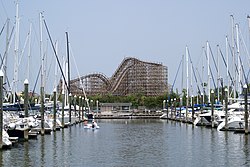2010 census
As of the census [37] of 2010, 4,970 people, 1,815 households, and 1,121 families resided in the CDP. The population density was 894.1 inhabitants per square mile (345.2/km2). The 2,293 housing units averaged 469.7 per square mile (181.4/km2). The racial makeup of the CDP was 80.41% White, 0.80% African American, 0.82% Native American, 7.61% Asian, 0.11% Pacific Islander, 8.27% from other races, and 1.97% from two or more races. Hispanics or Latinos of any race were 14.36% of the population.
Of the 1,815 households, 25.1% had children under the age of 18 living with them, 48.6% were married couples living together, 7.3% had a female householder with no husband present, and 38.2% were not families. About 30.0% of all households were made up of individuals, and 8.5% had someone living alone who was 65 years of age or older. The average household size was 2.39 and the average family size was 2.99.
In the CDP, the population was spread out, with 23.0% under the age of 18, 7.4% from 18 to 24, 30.8% from 25 to 44, 28.5% from 45 to 64, and 10.3% who were 65 years of age or older. The median age was 39 years. For every 100 females, there were 110.4 males. For every 100 females age 18 and over, there were 112.8 males.
The median income for a household in the CDP was $31,687, and for a family was $40,656. Males had a median income of $32,574 versus $25,526 for females. The per capita income for the CDP was $19,422. About 14.8% of families and 19.7% of the population were below the poverty line, including 33.5% of those under age 18 and 2.3% of those age 65 or over.
As of 1986, the community is primarily residential. During weekends and summer, many people stayed in their cottages and small houses. [10]
As of 2012, San Leon, Bayview, and Bacliff together make up the largest unincorporated community in the mainland portion of Galveston County by population. [38] As of July 2019 the San Leon CDP included 2632 single family residences, 14 multi-family residences and 2116 vacant lots which provided a tax base of $369,924,758. [39]
In 2008, Phale Cassady Le, an outreach coordinator of Boat People SOS Houston, said that in San Leon and Bacliff, between 150 and 200 Vietnamese families were involved with crab-, oyster-, and shrimp-fishing operations. [40] According to Le, most of the Vietnamese have no house or boat insurance, and even if they did have this insurance, their English is not well developed enough to read the terms of the policies. [40] Many families had hand-made boats that were constructed over several years as the owner made more and more money. Nick Cenegy of The Galveston County Daily News said that the Vietnamese community in San Leon and Bacliff had a "tradition of self-reliance and wariness of outsiders." [40]
In 2017 there were 4,890 people organized into 2,036 households. [12]






